Potřebujeme váš souhlas k využití jednotlivých dat, aby se vám mimo jiné mohly ukazovat informace týkající se vašich zájmů. Souhlas udělíte kliknutím na tlačítko „OK“.
ASTM G173-03(2012)
Standard Tables for Reference Solar Spectral Irradiances: Direct Normal and Hemispherical on 37° Tilted Surface
Automaticky přeložený název:
Standardní Stoly pro referenční solární spektrální Irradiances: Přímá Normální a polokulovitý na 37 ° nakloněné povrchy
NORMA vydána dne 1.11.2012
Informace o normě:
Označení normy: ASTM G173-03(2012)
Poznámka: NEPLATNÁ
Datum vydání normy: 1.11.2012
Kód zboží: NS-57524
Počet stran: 21
Přibližná hmotnost: 63 g (0.14 liber)
Země: Americká technická norma
Kategorie: Technické normy ASTM
Kategorie - podobné normy:
Anotace textu normy ASTM G173-03(2012) :
Keywords:
direct normal, hemispherical, irradiance, solar constant, solar spectrum, terrestrial, wavelength, ICS Number Code 17.180.01 (Optics and optical measurement in general)
Doplňující informace
| Significance and Use | ||||
|
4.1 Absorptance, reflectance, and transmittance of solar energy are important factors in material degradation studies, solar thermal system performance, solar photovoltaic system performance, biological studies, and solar simulation activities. These optical properties are normally functions of wavelength, which require the spectral distribution of the solar flux be known before the solar-weighted property can be calculated. To compare the relative performance of competitive products, or to compare the performance of products before and after being subjected to weathering or other exposure conditions, a reference standard solar spectral distribution is desirable. 4.2 These tables provide appropriate standard spectral irradiance distributions for determining the relative optical performance of materials, solar thermal, solar photovoltaic, and other systems. The tables may be used to evaluate components and materials for the purpose of solar simulation where either the direct or the hemispherical (that is, direct beam plus diffuse sky) spectral solar irradiance is desired. However, these tables are not intended to be used as a benchmark for ultraviolet radiation used in indoor exposure testing of materials using manufactured light sources. 4.3 The total integrated irradiances for the direct and hemispherical tilted spectra are 900.1 W·m-2 and 1000.4 W·m-2, respectively. Note that, in PV applications, no amplitude adjustments are required to match standard reporting condition irradiances of 1000 W·m-2 for hemispherical irradiance. 4.4 Previously defined global hemispherical reference spectrum (G159) for a sun-facing 37°-tilted surface served well to meet the needs of the flat plate photovoltaic research, development, and industrial community. Investigation of prevailing conditions and measured spectra shows that this global hemispherical reference spectrum can be attained in practice under a variety of conditions, and that these conditions can be interpreted as representative for many combinations of atmospheric parameters. Earlier global hemispherical reference spectrum may be closely, but not exactly, reproduced with improved spectral wavelength range, uniform spectral interval, and spectral resolution equivalent to the spectral interval, using inputs in X1.4. 4.5 Reference spectra generated by the SMARTS Version 2.9.2 model for the indicated conditions are shown in Card ID |
Value |
Parameter/Description/Variable Name |
||
|
1 |
'ASTM_G 173_Std_Spectra' |
Header |
||
|
2 |
1 |
Pressure input mode (1 = pressure and altitude): ISPR |
||
|
2a |
1013.25 0. |
Station Pressure (mb) and altitude (km): SPR, ALT |
||
|
3 |
1 |
Standard Atmosphere Profile Selection (1 = use default atmosphere): IATM1 |
||
|
3a |
'USSA' |
Default Standard Atmosphere Profile: ATM |
||
|
4 |
1 |
Water Vapor Input (1 = default from Atmospheric Profile): IH2O |
||
|
5 |
1 |
Ozone Calculation (1 = default from Atmospheric Profile): IO3 |
||
|
6 |
1 |
Pollution level mode (1 = standard conditions/no pollution): IGAS (see X1.3) |
||
|
7 |
370 |
Carbon Dioxide volume mixing ratio (ppm): qCO2 (see 7a |
1 |
Extraterrestrial Spectrum (1 = SMARTS/Gueymard): ISPCTR |
|
8 |
'S&F_RURAL' |
Aerosol Profile to Use: AEROS |
||
|
9 |
0 |
Specification for aerosol optical depth/turbidity input (0 = AOD at 500 nm): ITURB |
||
|
9a |
0.084 |
Aerosol Optical Depth at 500 nm: TAU5 |
||
|
10 |
38 |
Far field Spectral Albedo file to use (38= Light Sandy Soil): IALBDX |
||
|
10b |
1 |
Specify tilt calculation (1 = yes): ITILT |
||
|
10c |
38 37 180 |
Albedo and Tilt variables-Albedo file to use for near field, Tilt, and Azimuth: IALBDG, TILT, WAZIM |
||
|
11 |
280 4000 1.0 1367.0 |
Wavelength Range-start, stop, mean radius vector correction, integrated solar spectrum irradiance: WLMN, WLMX, SUNCOR, SOLARC |
||
|
12 |
2 |
Separate spectral output file print mode (2 = yes): IPRT |
||
|
12a |
280 4000 .5 |
Output file wavelength-Print limits, start, stop, minimum step size: WPMN, WPMX, INTVL |
||
|
12b |
2 |
Number of output variables to print: IOTOT |
||
|
12c |
8 9 |
Code relating output variables to print (8 = Hemispherical tilt, 9 = direct normal + circumsolar): OUT(8), OUT(9) |
||
|
13 |
1 |
Circumsolar calculation mode (1 = yes): ICIRC |
||
|
13a |
0 2.9 0 |
Receiver geometry-Slope, View, Limit half angles: SLOPE, APERT, LIMIT |
||
|
14 |
0 |
Smooth function mode (0 = none): ISCAN |
||
|
15 |
0 |
Illuminance calculation mode (0 = none): ILLUM |
||
|
16 |
0 |
UV calculation mode (0 = none): IUV |
||
|
17 |
2 |
Solar Geometry mode (2 = Air Mass): IMASS |
||
|
17a |
1.5 |
Air mass value: AMASS |
4.6 The availability of the adjunct (ADJG173CD4.7 Differences from the previous standard spectra (G159) can be summarized as follows:
4.7.1 Extended spectral interval in the ultraviolet (down to 280 nm, rather than 305 nm),
4.7.2 Better resolution (2002 wavelengths, as compared to 120),
4.7.3 Constant intervals (0.5 nm below 400 nm, 1 nm between 400 and 1700 nm, and 5 nm above),
4.7.4 Better definition of atmospheric scattering and gaseous absorption, with more species considered,
4.7.5 Better defined extraterrestrial spectrum,
4.7.6 More realistic spectral ground reflectance, and
4.7.7 Lower aerosol optical depth, yielding significantly larger direct normal irradiance.
1.1 These tables contain terrestrial solar spectral irradiance distributions for use in terrestrial applications that require a standard reference spectral irradiance for hemispherical solar irradiance (consisting of both direct and diffuse components) incident on a sun-facing, 37° tilted surface or the direct normal spectral irradiance. The data contained in these tables reflect reference spectra with uniform wavelength interval (0.5 nanometer (nm) below 400 nm, 1 nm between 400 and 1700 nm, an intermediate wavelength at 1702 nm, and 5 nm intervals from 1705 to 4000 nm). The data tables represent reasonable cloudless atmospheric conditions favorable for photovoltaic (PV) energy production, as well as weathering and durability exposure applications.
1.2 The 37° slope of the sun-facing tilted surface was chosen to represent the average latitude of the 48 contiguous United States. A wide variety of orientations is possible for exposed surfaces. The availability of the SMARTS model (as an adjunct, ADJG173CD3) to this standard) used to generate the standard spectra allows users to evaluate differences relative to the surface specified here.
1.3 The air mass and atmospheric
extinction parameters are chosen to provide (1) historical
continuity with respect to previous standard spectra, (
Standard Solar Constant and Zero Air Mass
Solar Spectral Irradiance Tables Simple Model for Atmospheric Transmission
of Sunshine Standard Terminology of Solar Energy
Conversion


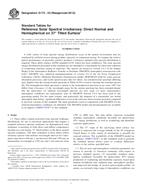
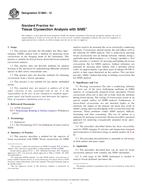 ASTM E1880-12
ASTM E1880-12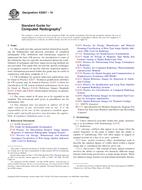 ASTM E2007-10
ASTM E2007-10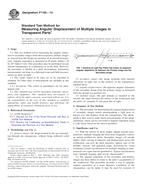 ASTM F1165-10
ASTM F1165-10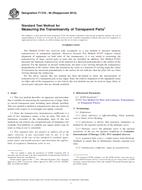 ASTM F1316-90(2013)..
ASTM F1316-90(2013)..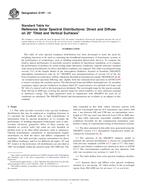 ASTM G197-14
ASTM G197-14
 Cookies
Cookies
